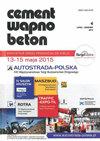Utilization of ground waste glass cullet in the industrial production of precast concrete elements
IF 0.6
4区 工程技术
Q4 CONSTRUCTION & BUILDING TECHNOLOGY
引用次数: 3
Abstract
In the study, a field trial was carried out to evaluate the applicability of ground waste glass cullet as a binder component, in the industrial production of precast concrete elements. The influence of glass cullet addition on the properties of fresh and hardened concretes was compared to siliceous fly ash. Moreover, the effects of a partial substitution of the natural aggregate with recycled concrete and expanded clay aggregate were determined. The compressive strength of concretes, in which 25% of cement was substituted with ground waste glass cullet, was even 20% higher compared to elements with an analogous addition of siliceous fly ash. Over 56 days, no drops in strength related to the harmful effects of the alkali-silica reaction were observed. Replacing half of the natural aggregate with graded recycled concrete aggregate, allowed to lower the thermal conductivity of the walls by approx. 10%, with no negative impact on the compressive strength of precast elements. However, a decrease in the consistency of fresh mix was observed after 30 minutes. Replacing the 2÷8 mm gravel with the same fraction of expanded clay resulted in an approx. 18% decrease in thermal conductivity, while maintaining satisfactory mechanical properties. It was concluded that ground waste glass cullet can be successfully used as a fly ash replacement in the production of precast concrete elements.地面废玻璃屑在混凝土预制构件工业生产中的利用
在研究中,进行了现场试验,以评估地面废玻璃碎料作为粘结剂成分在预制混凝土构件工业生产中的适用性。研究了玻璃屑掺量对新拌混凝土和硬化混凝土性能的影响,并与硅质粉煤灰进行了比较。此外,还确定了再生混凝土和膨胀粘土骨料部分替代天然骨料的效果。混凝土的抗压强度,其中25%的水泥是用磨碎的废玻璃屑代替的,甚至比添加类似硅质粉煤灰的元素高出20%。在56天内,没有观察到与碱-硅反应有害影响相关的强度下降。用分级再生混凝土骨料代替一半的天然骨料,使墙体的导热性降低了大约。10%,对预制构件抗压强度无负面影响。然而,30分钟后观察到新鲜混合物的稠度下降。将2÷8 mm的砾石替换为相同比例的膨胀粘土,结果约为。导热系数降低18%,同时保持令人满意的机械性能。试验结果表明,地面废玻璃屑可成功地替代粉煤灰用于混凝土预制构件的生产。
本文章由计算机程序翻译,如有差异,请以英文原文为准。
求助全文
约1分钟内获得全文
求助全文
来源期刊

Cement Wapno Beton
CONSTRUCTION & BUILDING TECHNOLOGY-MATERIALS SCIENCE, COMPOSITES
CiteScore
1.30
自引率
28.60%
发文量
0
审稿时长
>12 weeks
期刊介绍:
The Publisher of the scientific bimonthly of international circulation, entitled "Cement-Wapno-Beton" ["Cement-Lime-Concrete"], is the Fundacja Cement, Wapno, Beton [Foundation Cement, Lime, Concrete]. The periodical is dedicated to the issues concerning mineral setting materials and concrete. It is concerned with the publication of academic and research works from the field of chemistry and technology of building setting materials and concrete
 求助内容:
求助内容: 应助结果提醒方式:
应助结果提醒方式:


